Killers from Outer Space
A newly revised scale rates the risk that an asteroid may crash into Earth and wipe out life as we know it.
Share this:
- Share via email (Opens in new window) Email
- Click to share on Facebook (Opens in new window) Facebook
- Click to share on X (Opens in new window) X
- Click to share on Pinterest (Opens in new window) Pinterest
- Click to share on Reddit (Opens in new window) Reddit
- Share to Google Classroom (Opens in new window) Google Classroom
- Click to print (Opens in new window) Print
By Emily Sohn
It happened to the dinosaurs. It could happen to us.
At any moment, a giant chunk of rock could come screaming down from outer space to slam into Earth. Such an impact very likely killed off the dinosaurs 65 million years ago.
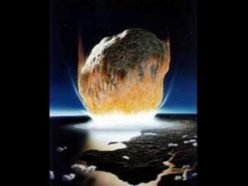 |
|
An artist’s impression of a large asteroid striking a coastal area on Earth.
|
| Don Davis, NASA |
Don’t start panicking yet, though. No matter what you may have seen in science-fiction movies, our chances of ever experiencing such a devastating collision are mighty slim.
“The fact is that it’s unlikely we would ever see a major impact in our lifetimes,” says Richard Binzel. He’s a planetary scientist at the Massachusetts Institute of Technology in Cambridge, Mass. “But it’s possible.”
Luckily, Binzel and other space scientists are looking out for us. They regularly scan the skies for near-Earth objects (NEOs)—mostly rocky asteroids and icy comets. These objects orbit the sun, following pathways that come near to Earth or cross Earth’s orbit.
Identifying and cataloging NEOs is an important way to avoid disaster, Binzel says.
Binzel estimates that there are about 1,100 NEOs, measuring at least 1 kilometer across, that could someday pass dangerously close to Earth. If scientists were to learn that we’re on a collision course with one of these objects, they could start looking for ways to avoid disaster.
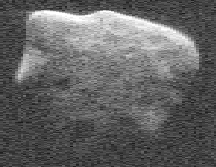 |
|
With an average diameter of 2 miles, the near-Earth asteroid known as 1999 JM8 is the largest potentially hazardous asteroid yet studied in detail. Although this object comes fairly close to Earth, there’s no risk of a collision for at least a few centuries. |
| NASA |
Studying NEOs is also an important way to let people know what’s going on in our astronomical neighborhood. To that end, Binzel and his colleagues have recently revised a ranking system called the Torino scale. It rates NEOs on their chances of hitting Earth, just as the Richter scale ranks the severity of earthquakes.
“The message here is that it’s not doom and gloom,” Binzel says. “It’s a message that we’d like to understand what these objects are. Scaring people is not what this is all about.”
Scale of disaster
To give people a sense of whether an asteroid could strike Earth, an international group of astronomers adopted the Torino scale in 1999. It’s named after the city in Italy where the astronomers held their meeting.
On the scale, zero means virtually no chance of a collision, whereas 10 means certain global catastrophe.
“The idea was to create a simple system conveying clear, consistent information about near-Earth objects,” Binzel says.
Astronomers hoped that the public would learn to trust the scale. “We didn’t want anyone to think we were working in secret” or hiding important information, Binzel says.
Instead of building comfort and trust, however, the original Torino scale produced confusion and fear. You may have heard alarming news reports of asteroids hurtling toward Earth, only to learn a few months later that there was actually no chance of collision.
Tiny slices
Part of the problem, Binzel says, is that predicting an NEO’s path is hard to do.
Identification begins when astronomers notice an object moving against the backdrop of stars. Measurements and calculations then help them estimate where the object’s orbit will take it 1, 10, 30, or 50 years from now.
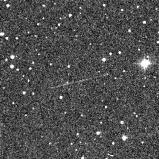 |
|
The faint streak is the trail left by an asteroid in this image from the Palomar Digital Sky Survey.
|
All of these estimates, however, are based on a tiny slice of information, Binzel says.
Predicting the path of an asteroid or comet, he says, is a lot like predicting the path of a hurricane or the path of a baseball right after a player hits it. You can guess where it’s heading, but only time will tell where it’s going to land.
“As you see the ball come off the bat, you think, ‘Omigosh, it’s going to hit me in the head,'” Binzel says. As you watch the ball continue on its path, though, you begin to get a better idea of where it’s going to land. “Ultimately, you say, ‘Oh, it’s a foul ball.'”
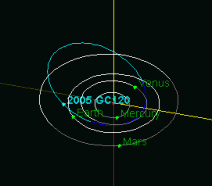 |
|
This diagram shows the orbit (blue) of a recently discovered, potentially hazardous, near-Earth asteroid known as 2005 GC120. It gives the positions of the asteroid, Earth, Mercury, Venus and Mars on May 4, 2005.
|
| NASA |
New levels
The new Torino scale attempts to give people a more accurate sense of what astronomers do and do not know about the near-Earth objects they discover (see below).
A level 0 object, for instance, has absolutely no chance of ever hitting us, Binzel says. Level 1 represents a newly discovered object that seems to present no unusual level of danger. With more information, this object would probably end up rated level 0.
The new Torino scale describes levels 2 to 4 as “meriting attention by astronomers.” The old system described them as “meriting concern,” which tended to scare people.
An NEO shouldn’t really hit the newspapers, Binzel says, until it reaches level 5 or higher. Even then, there’s no guarantee that doom is approaching.
“Critical attention by astronomers is needed to determine whether or not a collision will occur,” the scale says about levels 5 and 6.
At level 7, it recommends that governments around the world work together to do something—perhaps use rockets to nudge the object in another direction. No one has yet figured out how to do such a thing.
A level 10 NEO would surely be a frightening discovery. “A collision is certain,” the Torino scale says, “capable of causing global climatic catastrophe that may threaten the future of civilization as we know it, whether impacting land or ocean. Such events occur on average once per 100,000 years, or less often.”
A long, long time
A hundred thousand years is a long, long time between impact events, Binzel points out.
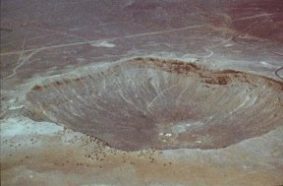 |
|
Meteor Crater in Arizona, created by an impact between 20,000 and 50,000 years ago, shows what can happen when a small asteroid, about 80 feet in diameter, strikes Earth.
|
| NASA |
In your own lifetime, there’s really no point in spending sleepless nights worrying about asteroids falling on your house, he says. “We’d like people to understand that this is something that merits attention by astronomers, but in terms of day-to-day activities, it doesn’t rank very high.”
Marveling at how interesting space is and how much is happening in our solar system would be a more productive activity, Binzel says. “Space is a very active, dynamic place.”
In other words, you still have to turn in your homework on time.
Going Deeper:
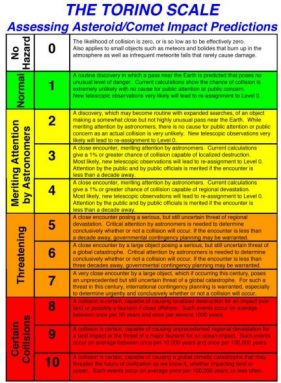 |






